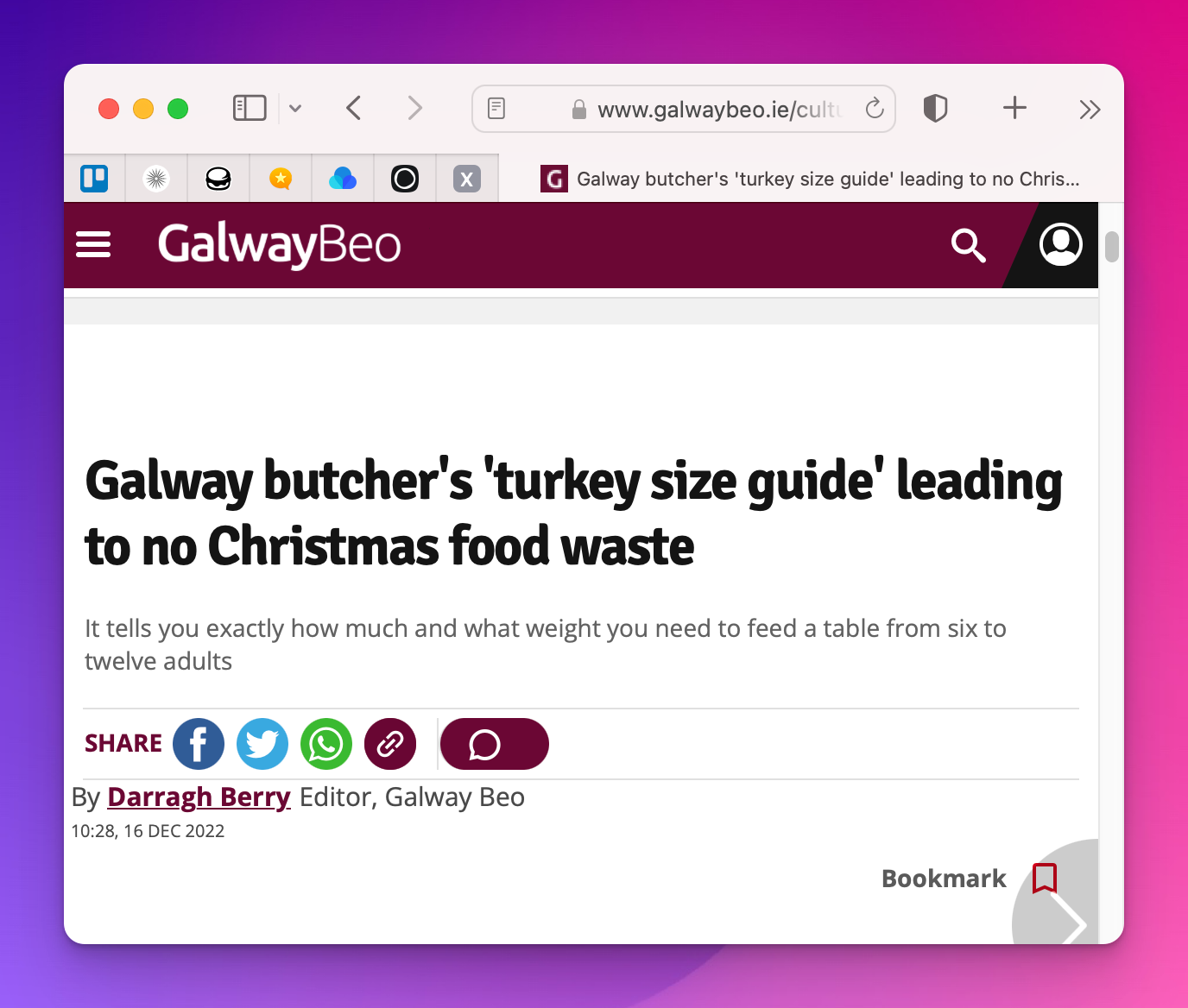Solution journalism in support of local environmental action in Ireland
Analysis of strengths and weaknesses in the Reach for Zero Campaign – and its ability to produce intended effects.

Final Assignment Part 1. Also read Part 2
Student: Per Axbom
Instructor: Camila Emboava Lopes
May 21, 2023
In March of 2022, the Reach publishing group launched a campaign – Reach for Zero – that included all of its major brands and magazines in Ireland and Northern Ireland. The campaign is an interesting blend of national and local news outlets working together, sourcing content from readers and engaging actively on social media.
Reach PLC is the UK and Ireland's largest commercial news publisher with more than 130 print and online brands, and with a monthly audience of 48 million readers. Among their titles in Ireland and Northern Ireland are Irish Mirror, Buzz, Dublin Live, Belfast Live, Cork Beo, Galway Beo and many more.
By working together across all brands, with a clear message and intent to involve readers, the campaign Reach for Zero provided a significant platform with regards to reach and potential for a huge impact. The output from the campaign is best described as regular news articles covering both global and local solutions and efforts to combat climate change, with an effort to create a positive outlook, and ultimately to encourage citizens to be more hopeful and themselves be inspired to contribute in their own ways. As such it embraces the idea that "a (hyper)local digital communication space can help to stimulate and facilitate a public discourse on environmental issues" (Weder 2020, 225).
The following diagram maps out the overarching components of the campaign:

Addressing sustainable development goals
Upon launch of the campaign there is a clear reference to the UN:s sustainability goals and on each of the outlets the main article introduces the topic as "the defining story of our time – what the United Nations has called a 'Code Red' emergency for humanity" (Dublin Live 2022). The purpose of the campaign is after this expressed as helping the reader understand "what we can do about [the climate crisis]".
With this general goal it's clear that it's possible to address many of the sustainable development goals outlined by the United Nations. What sets the campaign apart however, is its ability to directly address local communities more directly through its multitude of local news outlets. This means a potential for encouraging the types of actions that can be performed on an individual basis, and are outlined in the UN's list of examples under Take Action for the Sustainable Development Goals [SDGs] (United Nations n.d. a).
Among these examples of SDGs (United Nations n.d. b) are:
- Donate what you don't use (in support of SDG goal #1: No Poverty)
- Waste less food and support local farmers (in support of SDG goal #2: Zero Hunger)
- Use only energy-efficient appliances and lightbulbs (in support of SDG goal #7: Affordable and Clean Energy)
- Bike, walk or use public transportation (in support of SDG goal #11: Sustainable Cities and Communities)
All of these of course contribute to what can be seen as the primary motivator for the campaign, to actually take charge and do something now to address global warming, in support of SDG goal #13: Climate Action.
A concrete example of campaign output that supports this thinking is a Christmas-themed piece in the Galway Beo (Berry 2022), talking about minimizing food waste with an example from a local butcher in Galway, a city of 83,000 people.

This article underscores how a local focus will often involve not only private individuals but also local small businesses. In this way media allocates responsibility to specific sectors (Weder 2020, 233). By promoting climate action, local businesses are reminded and incentivised to act in support of sustainable development goals. This in turn this reflects well on them and makes it easier for their clients to understand how they can be a part of the change. Through the sharing of articles across different outlets in the campaign the business will also gain further exposure. Local activism is thus boosted when it is closely monitored by legacy media (Broitman & Jara 2020, 123).
Strengths and opportunities in the Reach for Zero campaign
The potential for reach provides this campaign with significant potential to boost environmental consciousness and stimulate climate action. The willingness to listen to local stories and cover these across the many different participating outlets utilizes the power of storytelling and familarity in a way that can break through an otherwise overwhelming flourish of news. Local media re-establishes a relationship with the community and stimulates people to act (Weder 2020, 234).
Likewise, the effort to focus on opportunity rather than fear and dystopia opens up a space for readers and journalists alike to engage in more stories that incorporate inherent joy and wellbeing, itself contributing to a stronger base for climate action. Bringing this constructive perspective is often referred to as solution journalism (Weder 2020, 238).
Journalists themselves are also encouraged to bring more of these stories to light as their work will automatically gain more visibility through the network effects of the campaign. Allowing the stories to be shared between outlets also supports the idea of translocal learning and reflexivity in other cities (Mann 2020, 194), moving more people collectively towards system change.
Weaknesses and threats in the Reach for Zero campaign
The strength in sheer numbers of news outlets can also introduce a complexity that detracts from the impact. A campaign that is not borne out of the organisation itself (i.e. the news outlet), but top-down from a corporate entity (i.e. Reach PLC), can lead to unclear goals and inconsistency in messaging.
When looking at how the different brands have implemented different pages that list all the news items that are part of the campaign Reach For Zero, it is clear that there are many stories that make it into the mix that are of a general global nature, and some with a negative political spin, calling out for example decisions made by lawmakers.
In fact, the story promoted as part of the campaign right next to the previously mentioned Christmas turkey story, is one that brings attention to the full-blown famine in Somalia (Corr 2022). And Belfast Live inserts this story next to articles about local recycling: Department for Economy cancel three energy crisis meetings with All Party Group on Climate Action (Corr 2022).
Failing to stick to the promised core message of what everyone themselves can do about the climate crisis erodes trust and attention. The stories with a global dystopian framing will tend to negatively impact the intent of the campaign and make it indistinguishable from any other 'traditional' climate reporting. Almgren (2020, 175) argues that perceived distancing from local concerns can be a catalyst for distrust. The global stories can also make it unclear whose needs are being addressed when urged to take action (Yang 2020, 216).
Conclusion
Size and reach is an important component of having a journalistic impact, but this also requires clear messaging and that everyone involved as a contributor understands the purpose and constraints of the campaign. A successful campaign anchored in solution journalism can falter, sometimes due to its own success, by attempting to use the same platform to push other types of content. The inherent risk is that this instead counteracts the very premise of the campaign and what originally made it successful.
Media must constantly consider if they are ignoring journalism that "might more effectively serve the needs of local populations" (Picard 2017, 253). The risk is that readers are pushed away by not recognising their needs.
References
- Almgren, Susanne M. (2017). 'News Users’ (Dis)trust in Media Performance : Challenges to Sustainable Journalism in Times of Xenophobia.' In P. Berglez, U. Olausson, M. Ots (eds.), What is Sustainable Journalism?, pp. 161-179. New York: Peter Lang.
- Corr, Shauna (2022). 'Charity appeal as "full-blown famine" expected across east African region', Galway Beo, March 1, viewed on May 18, 2023. https://www.galwaybeo.ie/news/ireland-news/charity-appeal-full-blown-famine-8199407
- Corr, Shauna (2022). 'Department for Economy cancel three energy crisis meetings with All Party Group on Climate Action', Belfast Live, 23 Sep, viewed on May 18, 2023. https://www.belfastlive.co.uk/news/northern-ireland/department-economy-cancel-three-energy-25083403
- Broitman, Claudio & Jara, René (2020). 'Surviving the Legacy Media System: The Place of Local Digital Activism in the Chiloé Red Tide Crisis.' In J. Diaz-Pont, P. Maeseele, A. E. Sjölander, M. Mishra & K. Foxwell-Norton (eds.), The Local and the Digital in Environmental Communication, pp. 109-128. IAMCR/Palgrave.
- Dublin Live (2022). New campaign 'Reach For Zero' will help you make powerful changes to tackle climate crisis', Dublin Live, March 22, viewed on May 18, 2023.https://www.dublinlive.ie/news/new-campaign-reach-zero-help-23461712
- Berry, Darragh (2022). 'Galway butcher's 'turkey size guide' leading to no Christmas food waste', Galway Beo, Dec 16, viewed on May 18, 2023.https://www.galwaybeo.ie/culture/food-drink/galway-butchers-turkey-size-guide-7936797
- Mann, Alana (2020). Hacking the Foodscape: Digital Communication in the Co-design of Sustainable and Inclusive Food Environments. In J. Diaz-Pont, P. Maeseele, A. E. Sjölander, M. Mishra & K. Foxwell-Norton (eds.), The Local and the Digital in Environmental Communication, pp. 183-202. IAMCR/Palgrave.
- Picard, Robert G. (2017). Monitoring Media Sustainability: Economic and Business Revisions to Development Indicators. In P. Berglez, U. Olausson, M. Ots (eds.), What is Sustainable Journalism?, pp. 243-256. New York: Peter Lang.
- United Nations (n.d. a). Take Action for the Sustainable Development Goals. United Nations, viewed on May 18, 2023.. https://www.un.org/sustainabledevelopment/sustainable-development-goals/
- United Nations (n.d. b). Global Sustainable Development Goals. United Nations, viewed on May 18, 2023. https://sdgs.un.org/goals
- Weder, Franzisca (2020). Sparking an Interest in Local Water Issues: Social Media as an Enabler for (Hyper)local Community Engagement in Environmental Issues and the Role of Solution Journalism. In J. Diaz-Pont, P. Maeseele, A. E. Sjölander, M. Mishra & K. Foxwell-Norton (eds.), The Local and the Digital in Environmental Communication, pp. 223-245. IAMCR/Palgrave.
- Yang, Chamee (2020). Smart City and the Reinvented Politics of Governing Through Datafied Environment in Songdo, South Korea. In J. Diaz-Pont, P. Maeseele, A. E. Sjölander, M. Mishra & K. Foxwell-Norton (eds.), The Local and the Digital in Environmental Communication, pp. 203-221. IAMCR/Palgrave.
Also read





Comment